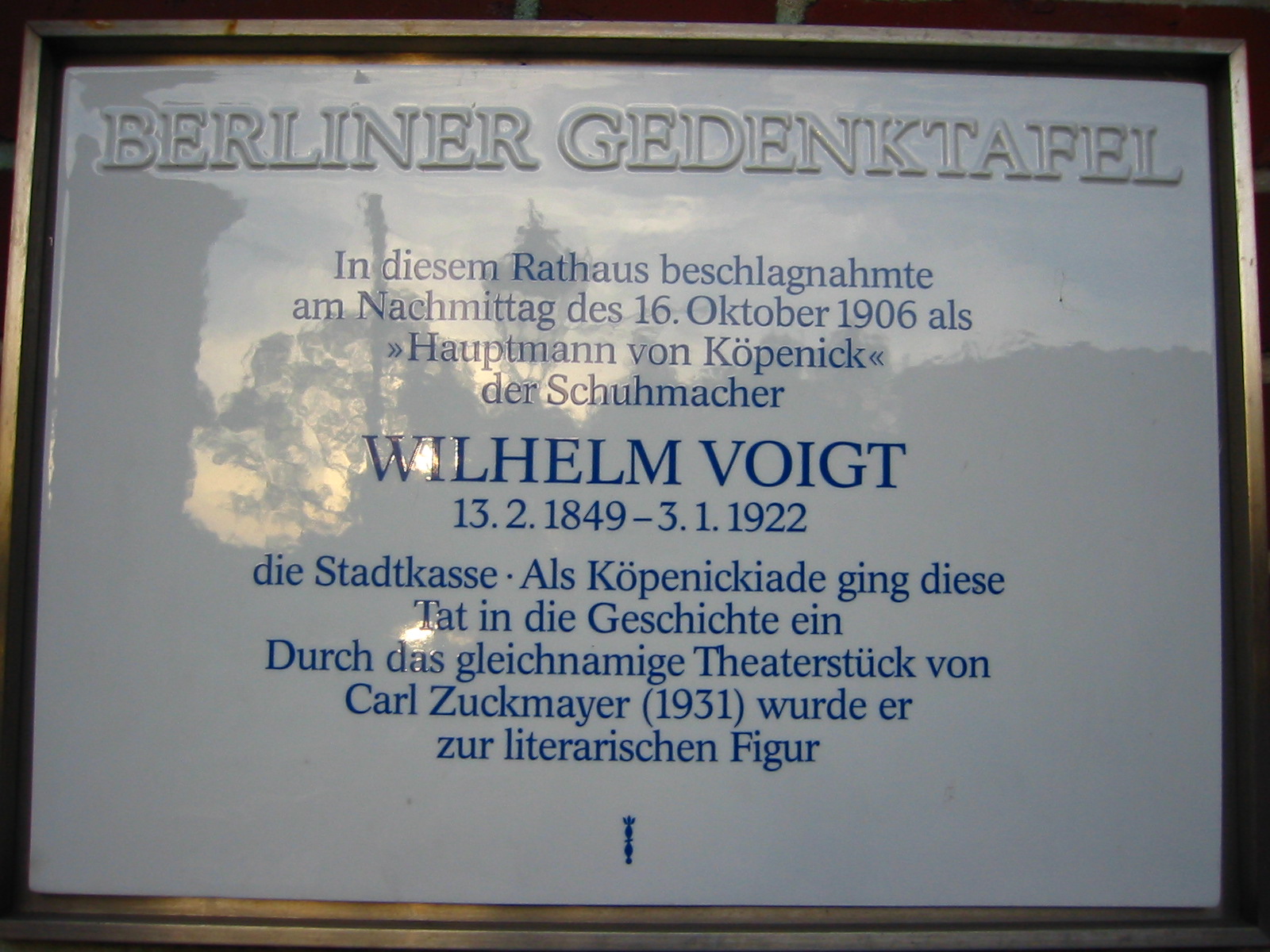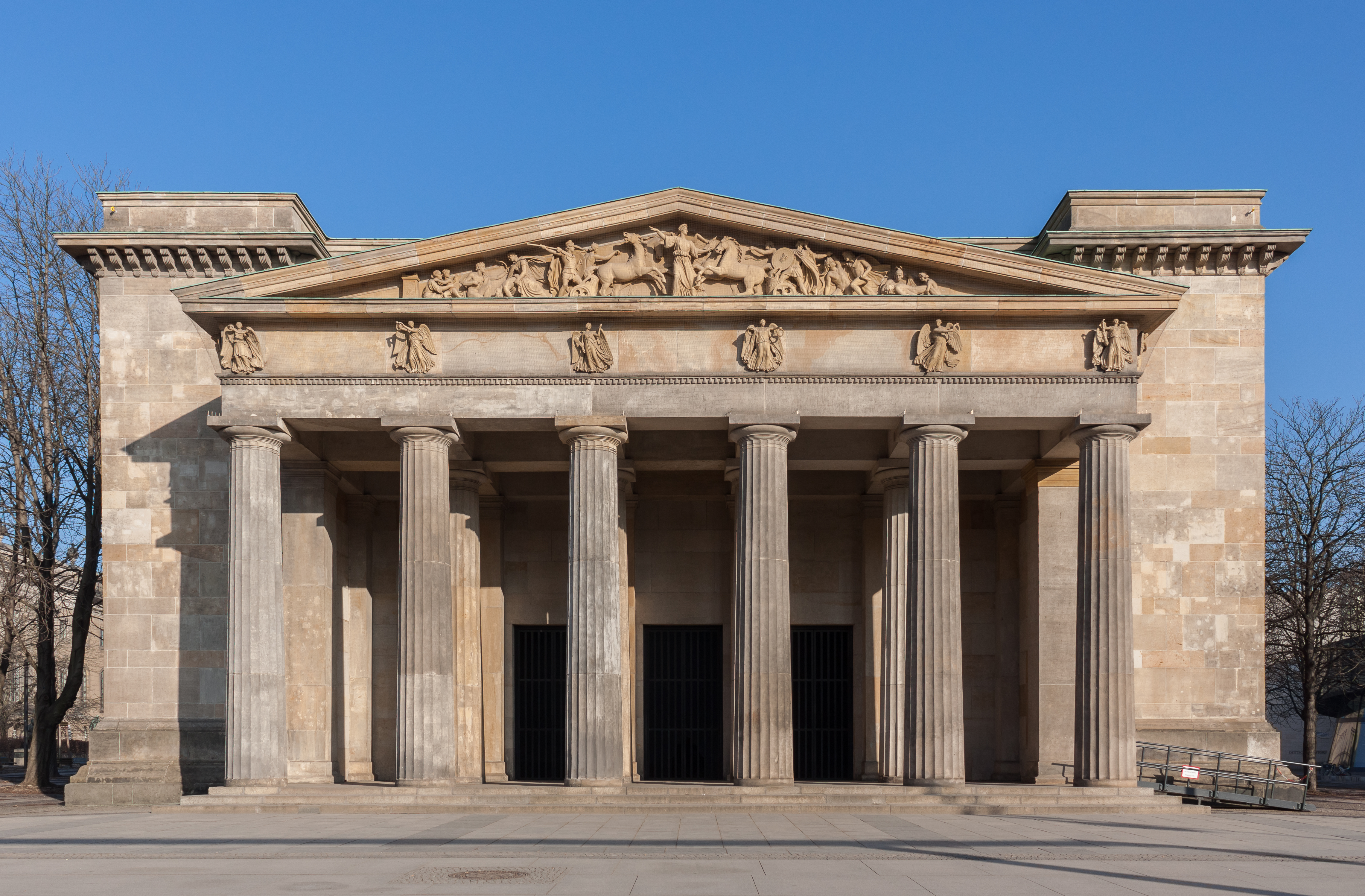|
Wilhelm Voigt
Friedrich Wilhelm Voigt (13 February 1849 – 3 January 1922) was a German impostor who, in 1906, masqueraded as a Prussian military officer, rounded up a number of soldiers under his "command", and "confiscated" more than 4,000 marks from a municipal treasury. Although he served two years in prison, he became a folk hero as "the Captain of Köpenick" (german: der Hauptmann von Köpenick ) and was pardoned by Kaiser Wilhelm II. Early life Voigt was born in Tilsit, Prussia (now Sovetsk, Kaliningrad Oblast). In 1863, aged 14, he was sentenced to 14 days in prison for theft, which led to his expulsion from school. He learned shoemaking from his father. Between 1864 and 1891, Voigt was sentenced to prison for a total of 25 years for thefts, forgery and burglary. The longest sentence was a 15-year conviction for an unsuccessful burglary of a court cashier's office. He was released on 12 February 1906. Voigt drifted from place to place until he went to live with his sister in Ri ... [...More Info...] [...Related Items...] OR: [Wikipedia] [Google] [Baidu] |
Tilsit
Sovetsk (russian: Сове́тск; german: Tilsit; Old Prussian: ''Tilzi''; lt, Tilžė; pl, Tylża) is a town in Kaliningrad Oblast, Russia, located on the south bank of the Neman River which forms the border with Lithuania. Geography Sovetsk lies in the historic region of Lithuania Minor at the confluence of the Tilse and Neman rivers. Panemunė in Lithuania was formerly a suburb of the town; after Germany's defeat in World War I, the trans-Neman suburb was detached from Tilsit (with the rest of the Klaipėda Region) in 1920. Climate Sovetsk has a borderline oceanic climate (''Cfb'' in the Köppen climate classification) using the boundary, or a humid continental climate (''Dfb'') using the boundary. History Tilsit, which received civic rights from Albert, Duke of Prussia in 1552,''Słownik geograficzny Królestwa Polskiego i innych krajów słowiańskich, Tom XII'', p. 703 developed around a castle of the Teutonic Knights, known as the Schalauer Haus, founded in 128 ... [...More Info...] [...Related Items...] OR: [Wikipedia] [Google] [Baidu] |
Neue Wache
The Neue Wache ( en, New Guard) is a listed building on Unter den Linden boulevard in the historic centre of Berlin, Germany. Erected from 1816 to 1818 according to plans by Karl Friedrich Schinkel as a guardhouse for the Royal Palace and a memorial to the Liberation Wars, it is considered a major work of Prussian Neoclassical architecture. A Victoria pedimental sculpture by Johann Gottfried Schadow and five General statues by Christian Daniel Rauch, referring to the Warrior statues on Schlossbrücke, also belong to the ensemble. Since 1993, the Neue Wache has been home to the Central Memorial of the Federal Republic of Germany to the Victims of War and Tyranny. History King Frederick William III of Prussia ordered the construction of the Neue Wache as a guardhouse for the Königliches Palais (Royal Palace), his palace across the road, to replace the old Artillery Guardhouse. He commissioned Schinkel, the leading exponent of Neoclassical architecture, to design the building: thi ... [...More Info...] [...Related Items...] OR: [Wikipedia] [Google] [Baidu] |
Pfennig
The 'pfennig' (; . 'pfennigs' or ; symbol pf or ₰) or penny is a former German coin or note, which was the official currency from the 9th century until the introduction of the euro in 2002. While a valuable coin during the Middle Ages, it lost its value through the years and was the minor coin of the Mark currencies in the German Reich, West and East Germany, and the reunified Germany until the introduction of the euro. Pfennig was also the name of the subunit of the Danzig mark (1922–1923) and the Danzig gulden (1923–1939) in the Free City of Danzig (modern Gdańsk, Poland). Overview Name The word ''Pfennig'' (replacing the ''denarius'' or ''denarius'' as a low-denomination silver coin) can be traced back to the 8th century and also became known as the ''Penning'', ''Panni(n)g '', ''Pfenni(n)c'', ''Pfending'' and by other names, e.g. in Prussia until 1873, ''Pfenning''. The ''-ing''- or ''-inc'' suffix was used, in addition to ''-ung'', the formation of affil ... [...More Info...] [...Related Items...] OR: [Wikipedia] [Google] [Baidu] |
Bookkeeping
Bookkeeping is the recording of financial transactions, and is part of the process of accounting in business and other organizations. It involves preparing source documents for all transactions, operations, and other events of a business. Transactions include purchases, sales, receipts and payments by an individual person or an organization/corporation. There are several standard methods of bookkeeping, including the single-entry and double-entry bookkeeping systems. While these may be viewed as "real" bookkeeping, any process for recording financial transactions is a bookkeeping process. The person in an organisation who is employed to perform bookkeeping functions is usually called the bookkeeper (or book-keeper). They usually write the '' daybooks'' (which contain records of sales, purchases, receipts, and payments), and document each financial transaction, whether cash or credit, into the correct daybook—that is, petty cash book, suppliers ledger, customer ledger, etc. ... [...More Info...] [...Related Items...] OR: [Wikipedia] [Google] [Baidu] |
Mayor
In many countries, a mayor is the highest-ranking official in a municipal government such as that of a city or a town. Worldwide, there is a wide variance in local laws and customs regarding the powers and responsibilities of a mayor as well as the means by which a mayor is elected or otherwise mandated. Depending on the system chosen, a mayor may be the chief executive officer of the municipal government, may simply chair a multi-member governing body with little or no independent power, or may play a solely ceremonial role. A mayor's duties and responsibilities may be to appoint and oversee municipal managers and employees, provide basic governmental services to constituents, and execute the laws and ordinances passed by a municipal governing body (or mandated by a state, territorial or national governing body). Options for selection of a mayor include direct election by the public, or selection by an elected governing council or board. The term ''mayor'' shares a linguistic ... [...More Info...] [...Related Items...] OR: [Wikipedia] [Google] [Baidu] |
Treasurer
A treasurer is the person responsible for running the treasury of an organization. The significant core functions of a corporate treasurer include cash and liquidity management, risk management, and corporate finance. Government The treasury of a country is the department responsible for the country's economy, finance and revenue. The treasurer is generally the head of the treasury, although, in some countries (such as the United Kingdom or the United States) the treasury reports to a Secretary of the Treasury or Chancellor of the Exchequer. In Australia, the Treasurer is a senior minister and usually the second or third most important member of the government after the Prime Minister and Deputy Prime Minister. Each Australian state and self-governing territory also has its own treasurer. From 1867 to 1993, Ontario's Minister of Finance was called the Treasurer of Ontario. Originally the word referred to the person in charge of the treasure of a noble; however, it has now m ... [...More Info...] [...Related Items...] OR: [Wikipedia] [Google] [Baidu] |
City Hall (administration)
In local government, a city hall, town hall, civic centre (in the UK or Australia), guildhall, or a municipal building (in the Philippines), is the chief administrative building of a city, town, or other municipality. It usually houses the city or town council, its associated departments, and their employees. It also usually functions as the base of the mayor of a city, town, borough, county or shire, and of the executive arm of the municipality (if one exists distinctly from the council). By convention, until the middle of the 19th century, a single large open chamber (or "hall") formed an integral part of the building housing the council. The hall may be used for council meetings and other significant events. This large chamber, the "town hall" (and its later variant "city hall") has become synonymous with the whole building, and with the administrative body housed in it. The terms "council chambers", "municipal building" or variants may be used locally in preference t ... [...More Info...] [...Related Items...] OR: [Wikipedia] [Google] [Baidu] |
Sergeant
Sergeant (abbreviated to Sgt. and capitalized when used as a named person's title) is a rank in many uniformed organizations, principally military and policing forces. The alternative spelling, ''serjeant'', is used in The Rifles and other units that draw their heritage from the British light infantry. Its origin is the Latin , 'one who serves', through the French term . The term ''sergeant'' refers to a non-commissioned officer placed above the rank of a corporal, and a police officer immediately below a lieutenant in the US, and below an inspector in the UK. In most armies, the rank of sergeant corresponds to command of a squad (or section). In Commonwealth armies, it is a more senior rank, corresponding roughly to a platoon second-in-command. In the United States Army, sergeant is a more junior rank corresponding to a squad- (12 person) or platoon- (36 person) leader. More senior non-commissioned ranks are often variations on sergeant, for example staff sergeant, gunn ... [...More Info...] [...Related Items...] OR: [Wikipedia] [Google] [Baidu] |
Grenadier
A grenadier ( , ; derived from the word '' grenade'') was originally a specialist soldier who threw hand grenades in battle. The distinct combat function of the grenadier was established in the mid-17th century, when grenadiers were recruited from among the strongest and largest soldiers. By the 18th century, the grenadier dedicated to throwing hand grenades had become a less necessary specialist, yet in battle, the grenadiers were the physically robust soldiers who led assaults, such as storming fortifications in the course of siege warfare. Certain countries such as France (Grenadiers à Cheval de la Garde Impériale) and Argentina (Regiment of Mounted Grenadiers) established units of Horse Grenadiers and for a time the British Army had Horse Grenadier Guards. Like their infantry grenadier counterparts, these horse-mounted soldiers were chosen for their size and strength (heavy cavalry). Today, the term is also used to describe a soldier armed with a grenade launcher, a weapo ... [...More Info...] [...Related Items...] OR: [Wikipedia] [Google] [Baidu] |
Berliner Gedenktafel Wilhelm Voigt
Berliner is most often used to designate a citizen of Berlin, Germany Berliner may also refer to: People * Berliner (surname) Places * Berliner Lake, a lake in Minnesota, United States * Berliner Philharmonie, concert hall in Berlin, Germany * Berliner See, a lake in Mecklenburg-Vorpommern, Germany * Berliner Straße (other), multiple streets in Germany with the name Arts, Entertainment, Media * Berliner (format), a paper size in newspapers * ''Berliner Abendblatt'', the leading weekly newspaper in Berlin * Berliner Ensemble, a German theatre company * ''Berliner Kurier'', a regional daily tabloid * ''Berliner Messe'', or ''Berlin Mass'', a mass by Arvo Pärt * ''Berliner Morgenpost'', 2nd most read newspaper in Berlin * Berliner Symphoniker, symphony orchestra in Berlin * ''Berliner Verkehrsblätter'', a journal on public transport in Berlin * ''Berliner Woche'', advertising weekly in Berlin * ''Berliner Zeitung'', daily newspaper in Berlin * ''The Berliner'' (film ... [...More Info...] [...Related Items...] OR: [Wikipedia] [Google] [Baidu] |








